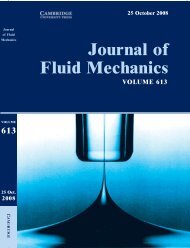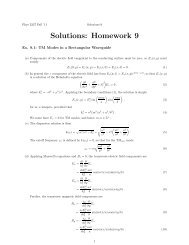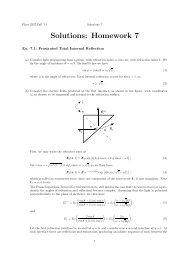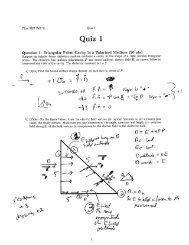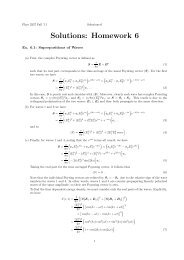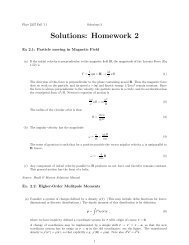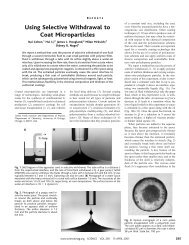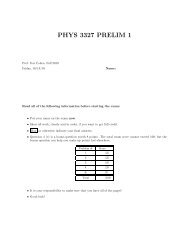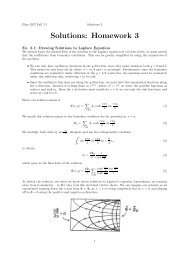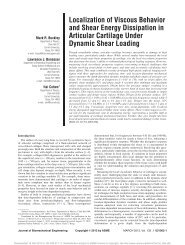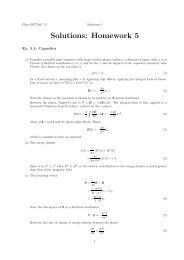Downloaded from rsif.royalsocietypublish<strong>in</strong>g.org on May 27, 2013(a)11(b)fruit fly (FF)parasitic wasp (PW)(c)honey bee (HB)mosquito (M)hawkmoth (HM)woolly aphid (WA)Harvard robot (HR) Cornell robot (CR) Mentor robot (MR)(d )CRWAManimals <strong>of</strong> known T RXNanimals with predicted T RXN<strong>passive</strong>ly stable robotsrobots that need active control<strong>passive</strong>lystablePW HR HBdamp<strong>in</strong>g time scale, T P/T IFFHMMR0.510 –1 110 10 2Figure 7. Control requirements for hover<strong>in</strong>g <strong>in</strong>sects, humm<strong>in</strong>gbirds <strong>and</strong> flapp<strong>in</strong>g-w<strong>in</strong>g robots. (a) Insects <strong>of</strong> vary<strong>in</strong>g size whose reaction time has been measured orestimated: fruit fly (typical <strong>body</strong> length 2.7 mm), honeybee (16 mm) <strong>and</strong> hawkmoth (46 mm). (b) Insects with unusual damp<strong>in</strong>g characteristics. The viscous drag on the<strong>body</strong> <strong>of</strong> the t<strong>in</strong>y wasp (0.6 mm) is significant, the mosquito (4.4 mm) flies with its long legs extended <strong>and</strong> the woolly aphid (3.2 mm) has a fibrous coat. (c) Robots withdifferent <strong>stabilization</strong> strategies: Harvard robot (15 mm) is externally stabilized with wire guides; Cornell robot (220 mm) has large sails; Mentor robot (360 mm) usessensory feedback control. (d) Reaction time needed to stabilize flight for hover<strong>in</strong>g animals (circles) <strong>and</strong> robots (squares). Reaction time is known for the fruit fly,honeybee <strong>and</strong> hawkmoth (filled circles) <strong>and</strong> predicted for other flyers (open symbols). Predictions are determ<strong>in</strong>ed by the rule <strong>of</strong> thumb that reactions must be sixtimes faster than the <strong>in</strong>stability, with variations with<strong>in</strong> the grey b<strong>and</strong> due to differences <strong>in</strong> the unplotted parameter T F /T I . (Onl<strong>in</strong>e version <strong>in</strong> colour.)52reaction time scale, T RXN/ T Irsif.royalsocietypublish<strong>in</strong>g.org J R Soc Interface 10: 20130237avenues for improvement <strong>and</strong> expansion. First, we havefocused on the <strong>pitch</strong> orientation dur<strong>in</strong>g normal hover<strong>in</strong>g, ascenario that a variety <strong>of</strong> models <strong>and</strong> simulations agree isplagued by a diverg<strong>in</strong>g oscillat<strong>in</strong>g <strong>in</strong>stability. It may be thatother degrees <strong>of</strong> freedom are also unstable dur<strong>in</strong>g normalhover<strong>in</strong>g. For example, recent CFD simulations <strong>in</strong>dicate thatroll <strong>of</strong> drone flies exhibits a fast diverg<strong>in</strong>g <strong>in</strong>stability [9],though reduced-order aerodynamic models f<strong>in</strong>d eitherslowly grow<strong>in</strong>g or decay<strong>in</strong>g oscillatory modes [12,13]. Ultimately,a clear picture <strong>of</strong> roll stability will probably emergefrom the comb<strong>in</strong>ation <strong>of</strong> flow simulations, aerodynamicmodels <strong>and</strong> experiments, at which po<strong>in</strong>t a similar controltheory analysis such as the one presented here should be developed.Similarly, future work might exam<strong>in</strong>e stability dur<strong>in</strong>gother flight modes, such as forward motion or ascent, <strong>and</strong>different w<strong>in</strong>g k<strong>in</strong>ematics, such as the vertical heav<strong>in</strong>gmotion <strong>of</strong> dragonflies. Based upon our study <strong>of</strong> <strong>pitch</strong> dur<strong>in</strong>gnormal hover<strong>in</strong>g, we anticipate that the physical stability propertiesdur<strong>in</strong>g these other flight conditions will place additionalconstra<strong>in</strong>ts on the sensory–motor systems needed for control.In spite <strong>of</strong> these caveats, however, our formulation doesallow us to make concrete <strong>and</strong> testable predictions. Forexample, our discovery that T RXN T I provides a powerfulway to estimate sensory–neural control characteristics frommorphological factors. Large flyerspwill generally be able toreact more slowly s<strong>in</strong>ce T RXN T I ≏ffiffiffiL ,whereL is the characteristiclength scale <strong>of</strong> the animal or robot. This analysis alsoshows that small fly<strong>in</strong>g <strong>in</strong>sects require fast reaction times.The millimetre-sized parasitic wasp [32], for example, is predictedto need a 7 ms <strong>stabilization</strong> reflex, which, if validated,would be among the fastest behavioural response times <strong>in</strong>the animal k<strong>in</strong>gdom [63–65]. Thus, flight control is most challeng<strong>in</strong>gat small scales <strong>and</strong> may be an important factor <strong>in</strong>determ<strong>in</strong><strong>in</strong>g the lower limit <strong>in</strong> <strong>body</strong> size <strong>of</strong> fly<strong>in</strong>g <strong>in</strong>sects.The strategy <strong>of</strong> us<strong>in</strong>g high-drag surfaces appears to beemployed by relatively few <strong>in</strong>sects. For example, the mosquitoby extend<strong>in</strong>g its long legs <strong>in</strong> flight provides damp<strong>in</strong>gthat would enable slower control, as <strong>in</strong>dicated <strong>in</strong> figure 7d.The woolly aphid represents a bizarre extreme <strong>in</strong> this strategy.Our calculations <strong>in</strong>dicate that its cotton-like fibrouscover<strong>in</strong>g provides such strong damp<strong>in</strong>g that the aphid maybe one <strong>of</strong> the few <strong>passive</strong>ly stable <strong>in</strong>sects.For biomimetic flapp<strong>in</strong>g-w<strong>in</strong>g robots, our time-scale formulationcould serve as an important guide <strong>in</strong> achiev<strong>in</strong>g stableflight. Like their biological counterparts, current prototypes canbe characterized <strong>in</strong> terms <strong>of</strong> <strong>passive</strong> versus active <strong>stabilization</strong>.Several implementations that have achieved <strong>passive</strong> stabilityrely on the addition <strong>of</strong> sails or tails which provide damp<strong>in</strong>g.For such designs, stability models can be used to determ<strong>in</strong>e thesize <strong>and</strong> placement <strong>of</strong> these surfaces [34,57]. Other roboticdesigns must rely on active control, <strong>and</strong> here our f<strong>in</strong>d<strong>in</strong>g thatthe reaction time be at least as fast the <strong>in</strong>ertial rotation time willprobably prove to be an important design criterion. In particular,our formulation shows that a key challenge <strong>in</strong> m<strong>in</strong>iaturiz<strong>in</strong>g suchdesigns will be <strong>in</strong> devis<strong>in</strong>g automatic control schemes that canrespond quickly enough to keep the device upright.F<strong>in</strong>ally, we speculate that the strategies used by fly<strong>in</strong>g<strong>in</strong>sects may have changed over the course <strong>of</strong> their 400 millionyears <strong>of</strong> evolution. In particular, early flyers are unlikely tohave had the fast <strong>and</strong> sophisticated sensory–neural systems<strong>of</strong> modern <strong>in</strong>sects <strong>and</strong> may <strong>in</strong>stead have relied on <strong>body</strong> plansthat confer <strong>in</strong>tr<strong>in</strong>sic stability [66]. Though the palaeontologicalrecord is too <strong>in</strong>complete to fully support this conjecture, fossil<strong>in</strong>sects do <strong>in</strong>clude damp<strong>in</strong>g features such as plate-like lobes<strong>and</strong> hair-like fibres [67]. The conspicuous absence <strong>of</strong> damp<strong>in</strong>gstructures <strong>in</strong> most modern <strong>in</strong>sects may reflect an adaptationtowards manoeuvrability <strong>and</strong> evasiveness <strong>in</strong> Nature’s<strong>in</strong>creas<strong>in</strong>gly crowded airspace.
Downloaded from rsif.royalsocietypublish<strong>in</strong>g.org on May 27, 2013References121. Dudley R. 2000 The biomechanics <strong>of</strong> <strong>in</strong>sect flight:form, function, evolution. Pr<strong>in</strong>ceton, NJ: Pr<strong>in</strong>cetonUniversity Press.2. Abzug MJ, Larrabee EE. 2002 Airplane stability <strong>and</strong>control: a history <strong>of</strong> the technologies that madeaviation possible. Cambridge, UK: CambridgeUniversity Press.3. Stengel RF. 2004 Flight dynamics. Pr<strong>in</strong>ceton, NJ:Pr<strong>in</strong>ceton University Press.4. V<strong>in</strong>centi WG. 1988 How did it become ‘obvious’that an airplane should be <strong>in</strong>herently stable? Invent.Technol. 51–56.5. Ste<strong>in</strong> G. 2003 Respect the unstable. IEEE Control Syst.Mag. 23, 12–25. (doi:10.1109/MCS.2003.1213600)6. Astrom KJ, Murray RM. 2008 Feedback systems: an<strong>in</strong>troduction for scientists <strong>and</strong> eng<strong>in</strong>eers. Pr<strong>in</strong>ceton,NJ: Pr<strong>in</strong>ceton University Press.7. Sun M, Xiong Y. 2005 Dynamic flight stability <strong>of</strong> ahover<strong>in</strong>g bumblebee. J. Exp. Biol. 208, 447–459.(doi:10.1242/jeb.01407)8. Sun M, Wang J, Xiong Y. 2007 Dynamic flightstability <strong>of</strong> hover<strong>in</strong>g <strong>in</strong>sects. Acta Mech. S<strong>in</strong>. 23,231–246. (doi:10.1007/s10409-007-0068-3)9. Zhang Y, Sun M. 2010 Dynamic flight stability <strong>of</strong>a hover<strong>in</strong>g model <strong>in</strong>sect: lateral motion. ActaMech. S<strong>in</strong>. 26, 175–190. (doi:10.1007/s10409-009-0303-1)10. Gao N, Aono H, Liu H. 2011 Perturbation analysis <strong>of</strong>6d <strong>of</strong> flight dynamics <strong>and</strong> <strong>passive</strong> dynamic stability<strong>of</strong> hover<strong>in</strong>g fruit fly Drosophila melanogaster.J. Theor. Biol. 270, 98–111. (doi:10.1016/j.jtbi.2010.11.022)11. Faruque I, Humbert JS. 2010 Dipteran <strong>in</strong>sect flightdynamics. Part 1. Longitud<strong>in</strong>al motion about hover.J. Theor. Biol. 264, 538–552. (doi:10.1016/j.jtbi.2010.02.018)12. Faruque I, Humbert JS. 2010 Dipteran <strong>in</strong>sect flightdynamics. II. Lateral-directional motion about hover.J. Theor. Biol. 265, 306–313. (doi:10.1016/j.jtbi.2010.05.003)13. Cheng B, Deng X. 2011 Translational <strong>and</strong> rotationaldamp<strong>in</strong>g <strong>of</strong> flapp<strong>in</strong>g flight <strong>and</strong> its dynamics <strong>and</strong>stability at hover<strong>in</strong>g. IEEE Trans. Robot. 27,849–864. (doi:10.1109/TRO.2011.2156170)14. Taylor GK, Krapp HG. 2007 Sensory systems <strong>and</strong>flight stability: what do <strong>in</strong>sects measure <strong>and</strong> why?Adv. Insect. Physiol. 34, 231–316. (doi:10.1016/S0065-2806(07)34005-8)15. Fraenkel G, Pr<strong>in</strong>gle JWS. 1938 Halteres <strong>of</strong> flies asgyroscopic organs <strong>of</strong> equilibrium. Nature 141,919–920. (doi:10.1038/141919a0)16. Pr<strong>in</strong>gle JWS. 1948 The gyroscopic mechanism <strong>of</strong> thehalteres <strong>of</strong> diptera. Phil. Trans. R. Soc. Lond. B 233,347–384. (doi:10.1098/rstb.1948.0007)17. Fayyazudd<strong>in</strong> A, Dick<strong>in</strong>son MH. 1996 Haltereafferents provide direct, electronic <strong>in</strong>put to asteer<strong>in</strong>g motor neuron <strong>in</strong> the blowfly, Calliphora.J. Neurosci. 16, 5225–5232.18. Heisenberg M, Wolf R. 1993 The sensory-motor l<strong>in</strong>k<strong>in</strong> motion-dependent flight control <strong>of</strong> flies. In Visualmotion <strong>and</strong> its role <strong>in</strong> the <strong>stabilization</strong> <strong>of</strong> gaze, pp.265–283. Amsterdam, The Netherl<strong>and</strong>s: Elsevier.19. Trimarchi JR, Murphey RK. 1997 The shak<strong>in</strong>g-b2mutation disrupts electrical synapses <strong>in</strong> a flightcircuit <strong>in</strong> adult Drosophila. J. Neurosci. 17,4700–4712.20. Dick<strong>in</strong>son MH. 1999 Haltere-mediated equilibriumreflexes <strong>of</strong> the fruit fly, Drosophila melanogaster.Phil. Trans. R. Soc Lond. B 354, 903–916. (doi:10.1098/rstb.1999.0442)21. Ristroph L, Bergou AJ, Ristroph G, Coumes K,Berman GJ, Guckenheimer J, Wang ZJ, <strong>Cohen</strong> I.2010 Discover<strong>in</strong>g the flight autostabilizer <strong>of</strong> fruitflies by <strong>in</strong>duc<strong>in</strong>g aerial stumbles. Proc. Natl Acad.Sci. USA 107, 4820–4824. (doi:10.1073/pnas.1000615107)22. Cowan NJ, Lee J, Full RJ. 2006 Task level control <strong>of</strong>rapid wall follow<strong>in</strong>g <strong>in</strong> the American cockroach.J. Exp. Biol. 209, 1617–1629. (doi:10.1242/jeb.02166)23. Cheng B, Deng X, Hedrick TL. 2011 The mechanics<strong>and</strong> control <strong>of</strong> <strong>pitch</strong><strong>in</strong>g manoeuvres <strong>in</strong> a freelyfly<strong>in</strong>g hawkmoth (M<strong>and</strong>uca sexta). J. Exp. Biol. 214,4092–4106. (doi:10.1242/jeb.062760)24. Elz<strong>in</strong>ga MJ, Dickson WB, Dick<strong>in</strong>son MH. 2012 The<strong>in</strong>fluence <strong>of</strong> sensory delay on the yaw dynamics <strong>of</strong> aflapp<strong>in</strong>g <strong>in</strong>sect. J. R. Soc. Interface, 9, 1685–1696.(doi:10.1098/rsif.2011.0699)25. Ristroph L, Bergou AJ, Berman GJ, Guckenheimer J,Wang ZJ, <strong>Cohen</strong> I. 2012 Dynamics, control, <strong>and</strong><strong>stabilization</strong> <strong>of</strong> turn<strong>in</strong>g flight <strong>in</strong> fruit flies. In Naturallocomotion <strong>in</strong> fluids <strong>and</strong> on surfaces, pp. 83–99.New York, NY: Spr<strong>in</strong>ger.26. Ristroph L, Berman GJ, Bergou AJ, Wang ZJ, <strong>Cohen</strong>I. 2009 Automated hull reconstruction motiontrack<strong>in</strong>g (HRMT) applied to sideways maneuvers <strong>of</strong>free-fly<strong>in</strong>g <strong>in</strong>sects. J. Exp. Biol. 212, 1324–1335.(doi:10.1242/jeb.025502)27. Zanker. 1990 W<strong>in</strong>gbeat <strong>of</strong> the fruit fly, Drosophilamelanogaster. I. K<strong>in</strong>ematics. Phil. Trans. R. Soc.Lond. B 327, 1–8. (doi:10.1098/rstb.1990.0040)28. Hedrick TL, Cheng B, Deng X. 2009 W<strong>in</strong>gbeat time<strong>and</strong> the scal<strong>in</strong>g <strong>of</strong> <strong>passive</strong> rotational damp<strong>in</strong>g <strong>in</strong><strong>in</strong>sect flight. Science 324, 252–255. (doi:10.1126/science.1168431)29. Bergou AJ, Ristroph L, Guckenheimer J, <strong>Cohen</strong> I,Wang ZJ. 2010 Fruit flies modulate <strong>passive</strong> w<strong>in</strong>g<strong>pitch</strong><strong>in</strong>g to generate <strong>in</strong>-flight turns. Phys. Rev. Lett.104, 148101. (doi:10.1103/PhysRevLett.104.148101)30. Ristroph L, Bergou AJ, Guckenheimer J, Wang ZJ,<strong>Cohen</strong> I. 2011 Paddl<strong>in</strong>g mode <strong>of</strong> forward flight <strong>in</strong><strong>in</strong>sects. Phys. Rev. Lett. 106, 178103. (doi:10.1103/PhysRevLett.106.178103)31. Ell<strong>in</strong>gton CP. 1984 The aerodynamics <strong>of</strong> hover<strong>in</strong>g<strong>in</strong>sect flight. II. Morphological parameters. Phil.Trans. R. Soc. Lond. B 305, 17–40. (doi:10.1098/rstb.1984.0050)32. Weis-Fogh T. 1973 Quick estimates <strong>of</strong> flight fitness<strong>in</strong> hover<strong>in</strong>g animals, <strong>in</strong>clud<strong>in</strong>g novel mechanisms <strong>of</strong>lift production. J. Exp. Biol. 59, 169–230.33. Ell<strong>in</strong>gton CP. 1984 The aerodynamics <strong>of</strong> hover<strong>in</strong>g<strong>in</strong>sect flight. III. K<strong>in</strong>ematics. Phil. Trans. R. Soc. Lond.B 305, 41–78. (doi:10.1098/rstb.1984.0051)34. Teoh ZE, Fuller SB, Chirarattananon PC, Perez-Aranciba NO, Greenberg JD, Wood RJ. 2012 Ahover<strong>in</strong>g flapp<strong>in</strong>g-w<strong>in</strong>g microrobot with altitudecontrol <strong>and</strong> <strong>passive</strong> upright stability. In Proc. IEEE/RSJ Int. Conf. on Intelligent Robots <strong>and</strong> Systems,Vilamoura-Algarve, Portugal, 7–12 October 2012.Piscataway, NJ: IEEE.35. Freudenberg JS, Looze DP. 1985 Right half planepoles <strong>and</strong> zeroes <strong>and</strong> design trade<strong>of</strong>fs <strong>in</strong> feedbacksystems. IEEE Trans. Auto. Control 30, 555–565.(doi:10.1109/TAC.1985.1104004)36. Astrom KJ. 2000 Limitations on control systemperformance. Eur. J. Control 6, 2–20.37. Fry SN, Sayaman R, Dick<strong>in</strong>son MH. 2003 Theaerodynamics <strong>of</strong> free-flight maneuvers <strong>in</strong>Drosophila. Science 300, 495–498. (doi:10.1126/science.1081944)38. Altshuler DL, Dickson WB, Vance JT, Roberts SP,Dick<strong>in</strong>son MH. 2005 Short-amplitude high-frequencyw<strong>in</strong>g strokes determ<strong>in</strong>e the aerodynamics <strong>of</strong> honeybeeflight. Proc. Natl Acad. Sci. USA 102, 18213.39. Dudley RB, Ell<strong>in</strong>gton CP. 1990 Mechanics <strong>of</strong> forwardflight <strong>in</strong> bumblebees. J. Exp. Biol. 148, 19–52.40. Liu Y, Sun M. 2007 W<strong>in</strong>g k<strong>in</strong>ematics measurement<strong>and</strong> aerodynamic force <strong>and</strong> moments computation<strong>of</strong> hover<strong>in</strong>g hoverfly. In Proc. Int. Conf. Bio<strong>in</strong>f.Biomed. Eng., Wuhan, People’s Republic <strong>of</strong> Ch<strong>in</strong>a,6–8 July 2007, pp. 452–455. Piscataway, NJ: IEEE.(doi:10.1109/ICBBE.2007.119)41. Liu Y, Sun M. 2008 W<strong>in</strong>g k<strong>in</strong>ematics measurement<strong>and</strong> aerodynamics <strong>of</strong> hover<strong>in</strong>g droneflies. J. Exp.Biol. 211, 2014–2025. (doi:10.1242/jeb.016931)42. Willmott AP, Ell<strong>in</strong>gton CP. 1997 The mechanics <strong>of</strong>flight <strong>in</strong> the hawkmoth M<strong>and</strong>uca sexta. I.K<strong>in</strong>ematics <strong>of</strong> hover<strong>in</strong>g <strong>and</strong> forward flight. J. Exp.Biol. 200, 2705–2722.43. Willmott AP, Ell<strong>in</strong>gton CP. 1997 The mechanics<strong>of</strong> flight <strong>in</strong> the hawkmoth M<strong>and</strong>uca sexta. II.Aerodynamic consequences <strong>of</strong> k<strong>in</strong>ematic <strong>and</strong>morphological variation. J. Exp. Biol. 200,2723–2745.44. Usherwood JR, Ell<strong>in</strong>gton CP. 2002 The aerodynamics<strong>of</strong> revolv<strong>in</strong>g w<strong>in</strong>gs. I. Model hawkmoth w<strong>in</strong>gs.J. Exp. Biol. 205, 1547–1564.45. Fry SN, Sayaman R, Dick<strong>in</strong>son MH. 2005 Theaerodynamics <strong>of</strong> hover<strong>in</strong>g flight <strong>in</strong> Drosophila. J. Exp.Biol. 208, 2303–2318. (doi:10.1242/jeb.01612)46. Dick<strong>in</strong>son MH, Lehmann F-O, Sane S. 1999 W<strong>in</strong>grotation <strong>and</strong> the aerodynamic basis <strong>of</strong> <strong>in</strong>sect flight.Science 284, 1954–1960. (doi:10.1126/science.284.5422.1954)47. Dudley R. 1995 Extraord<strong>in</strong>ary flight performance <strong>of</strong>orchid bees (apidae: Eugloss<strong>in</strong>i) hover<strong>in</strong>g <strong>in</strong> heliox(80 He/20 O 2 ). J. Exp. Biol. 198, 1065–1070.48. Ennos AR. 1989 The k<strong>in</strong>ematics <strong>and</strong> aerodynamics<strong>of</strong> the free flight <strong>of</strong> some diptera. J. Exp. Biol. 142,49–85.rsif.royalsocietypublish<strong>in</strong>g.org J R Soc Interface 10: 20130237



